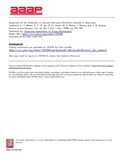| dc.description.abstract | Impaction of the proventriculus, gizzard, and sometimes intestines due to
sand was confirmed at postmortem in 25 cases involving ostriches (Struthio camelus). Al-
though there was no age predisposition, impaction was more common in juvenile over 3 mo
old. Clinical signs included sternal recumbency, outstretched neck, debility, and inability to
stand. Palpation of the impacted stomachs gave a gritty sensation. Depletion of coronary fat
was a consistent postmortem finding. The most common material causing impaction was
sand. This report highlights impaction as one of the major causes of debility and death in
intensively farmed ostriches. High levels of alkaline phosphatase coupled with low levels of
plasma glucose, protein, and albumin detected in impacted ostriches may be useful diagnostic
antemortem indicators of the syndrome | en_US |

